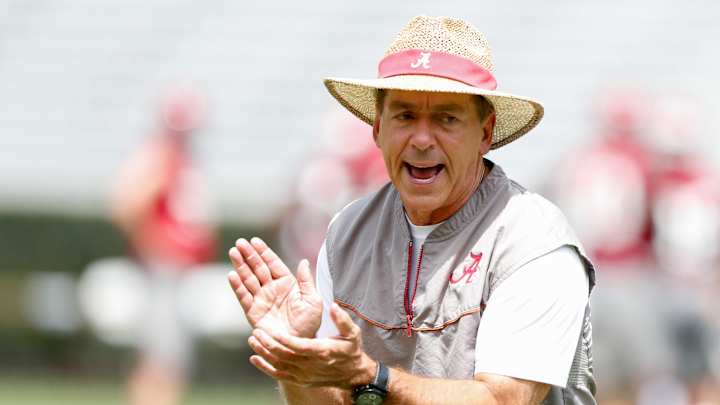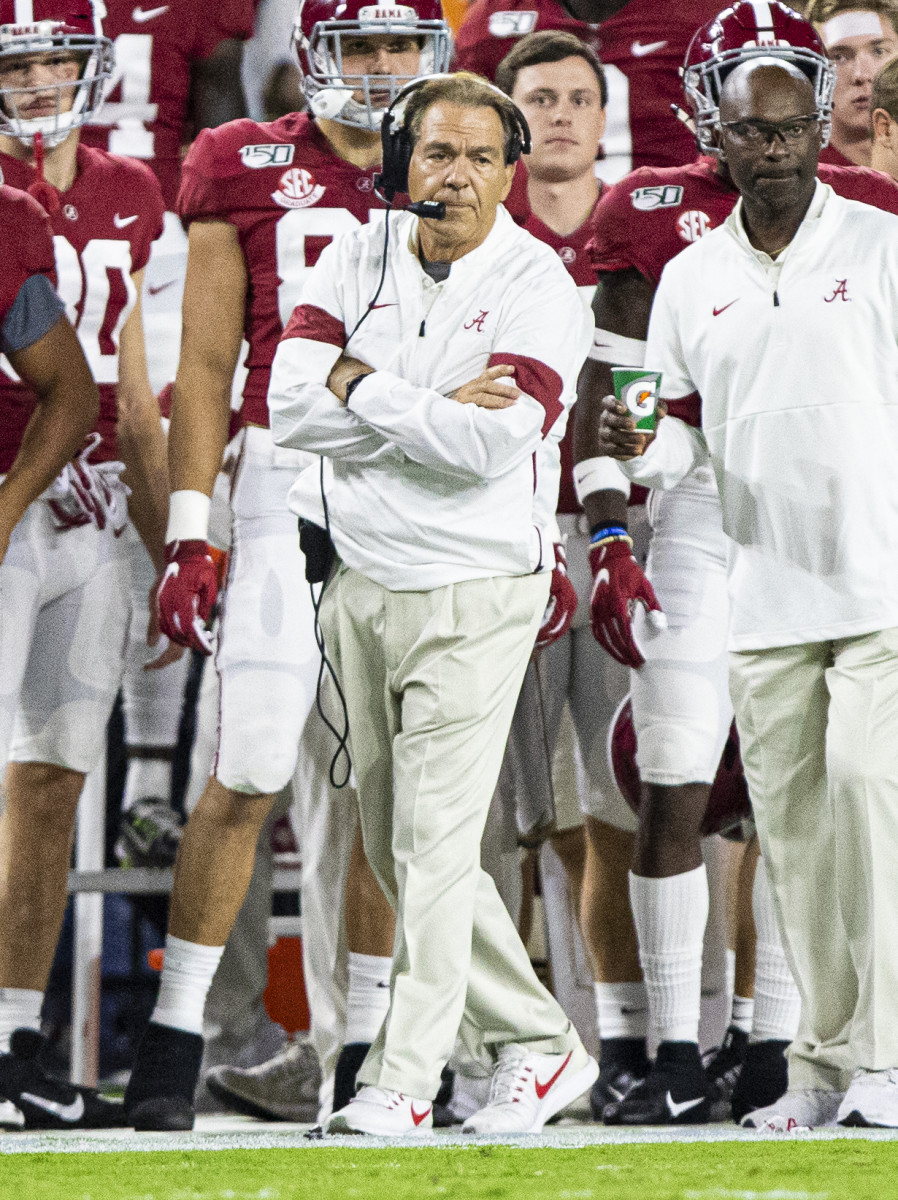Like With Most Things, Nick Saban Was Ahead of the Curve in Growing Field of Mental Health

TUSCALOOSA, Ala. — It began with something along the lines of what a player often doesn’t want to hear, and caught Ginger Gilmore-Childress a little by surprise: “Coach wants to see you.”
Only it wasn’t her coach who had requested the meeting.
In 2007, she had been the team trainer for Alabama baseball for a while, but with Jim Wells having announced his retirement (the first time) Gilmore-Childress was beginning to think about other possibilities.
She had never met Nick Saban before, but had read his book “How good do you want to be?” The day she went over to the football complex to talk with the Crimson Tide’s new football coach and he was interviewing someone else as well, a potential head trainer he was considering from UCF, Jeff Allen.
Saban was interested in adding Gilmore-Childress to the football staff especially for two reasons: 1) He wanted a female presence around the team so players who hadn’t had much of a father figure would have a person they could feel comfortable going to with their problems, and, 2) He was looking for someone to spearhead the Crimson Tide’s efforts in the field that’s now commonly referred to as mental health.
“Coach has been doing that since Michigan State,” she said.
“I said, ‘I can do that.’”
Fast forward to 2019 and Gilmore-Childress, who is close to finishing up her doctorate, is the director of the Crimson Tide’s behavioral health department. She has an “enormous” outsource staff to draw upon including 11 counselors who meet with students, on the hour, in multiple places five days a week. They include a sports psychologist and clinical psychologist, a tertiary group that can be called in if necessary, and an on-site psychiatrist.
“It’s important to mention that now with Greg Byrne our captain, he’s very much for mental health for student-athletes, so I do this for all sports,” she said. “There are 650 or so athletes and we have programming and behavioral mental health care for all of them.
“Their numbers are the same as the general population of the university.”

What Gilmore-Childress meant by that was athletes have to deal with a lot of the same things that affect students in general. Not only are the ratios almost identical, so are the issues and problems.
Grief counseling is a good example. Sleep issues are as well. Most are away from home for the first time and dealing with an immense amount of stress and pressure to succeed.
There’s a generational aspect to it as well. Most people between the ages of 17 and 24 aren’t facing the same issues as students from 10 or 20 years ago. Studies show that more than ever young people are just hoping to cope and get through the day.
“The perspectives on mental health represent not a ripple of change, but a wave of new reality, which faces all of us in intercollegiate athletics and higher education,” SEC commissioner Greg Sankey said during his opening comments at 2019 SEC Media Days.
He subsequently relayed two quotes that he termed as being “sobering,” the first from NBA commissioner Adam Silver at MIT's Sloan Analytics Conference in the spring: “I don't think it's unique to these players. I don't think it's something that is just going on around superstar athletes. I think it's a generational issue.”
From San Diego State University psychology professor, Jean Twenge, one of the world's leading experts on generational differences in American youth: “It's not an exaggeration to describe iGen or Generation Z as being on the brink of the worst mental health crisis in decades.”
Start of SEC Media Days: Commissioner Greg Sankey lays out a few themes the conference is looking at heading into the season.
— The Red & Black Sports (@redblacksports) July 15, 2019
—Legalization of sports betting
—Mental health of players
—Helping fans, writers and coaches understand high pressure officiating decisions pic.twitter.com/HrOZArPz7u
That doesn’t mean mental health issues haven’t been around, or are considered something new in sports. Gilmore-Childress sees a parallel with nutrition, and how everyone has learned just how important it is to not only to athletes but in general. Nutrition bars are now popping up all over college athletics, headed by experts like the Crimson Tide’s Amy Bragg.
That field has about a 10-year head start on mental health. Similarly, other schools have started modeling Alabama’s program and Gilmore-Childress’ position, just like they’ve been doing with Bragg.
“I’ve always been one of these people who is really into human behavior and the psychological disposition it takes to be a good competitor,” Saban said, “We’ve always had people involved in the mental health of our players for the last 25 years – all the years that I’ve been a head coach.
“These people are experts in human behavior. They’ve helped players and they’ve helped us to be able to help them, by understanding issues and problems and how we should coach those guys, how they need to be supported so they have a better chance to be successful. I think this is something that people are becoming more aware of now.”
Overall, a major goal is to try and reduce the stigma that’s often associated with mental health and for young athletes to treat something like depression or anxiety the same way they would a physical injury. One shouldn’t try and treat a concussion or a shoulder injury on his or her own, and there are people in place to help.
“It’s the same importance,” Gilmore-Childress said.” You can’t go out and function with an ankle sprain to whatever degree if that ankle sprain has affected your way of thinking, your way of acting, your decision making.
“Great, your ankle is better, but you’re not better. So what’s the support we can use in conjunction with that?”
More from Alabama head coach Nick Saban on mental health...
— Mackenzie Salmon (@mackenziesalmon) July 17, 2019
"Having people who are there to support you and help you understand those things can be very helpful," said Saban. pic.twitter.com/MRA7SeEvlW
Another big part of it is simply to be on the lookout for anyone struggling and to communicate those concerns. Sort of like how strength and conditioning coach Scott Cochran might talk with Allen about something he saw with a player in the weight room, a variety of people are on the lookout for signs that something’s amiss.
A nutritionist may notice someone isn’t eating. Teachers or tutors see a student falling asleep on them. In the middle of study hall a person suddenly starts crying.
Sometimes it doesn’t take a tip. Students will often stop Gilmore-Childress in a hallway or knock on her door. Often the key is just getting the conversation started, and listening after asking “What’s going on?”
“You can really make a difference,” Gilmore-Childress said. “Everyone’s on the same page in this building and that’s the point. It all comes from coach.”
How does Coach Saban care for his players beyond the football field? Ginger Gilmore-Childress of @UA_Athletics explains the school's approach to the mental wellbeing of its student-athletes in our latest feature. #Leaders18 https://t.co/jFrnt71baS
— LEADERS Performance (@Leaders_Insight) July 23, 2018
